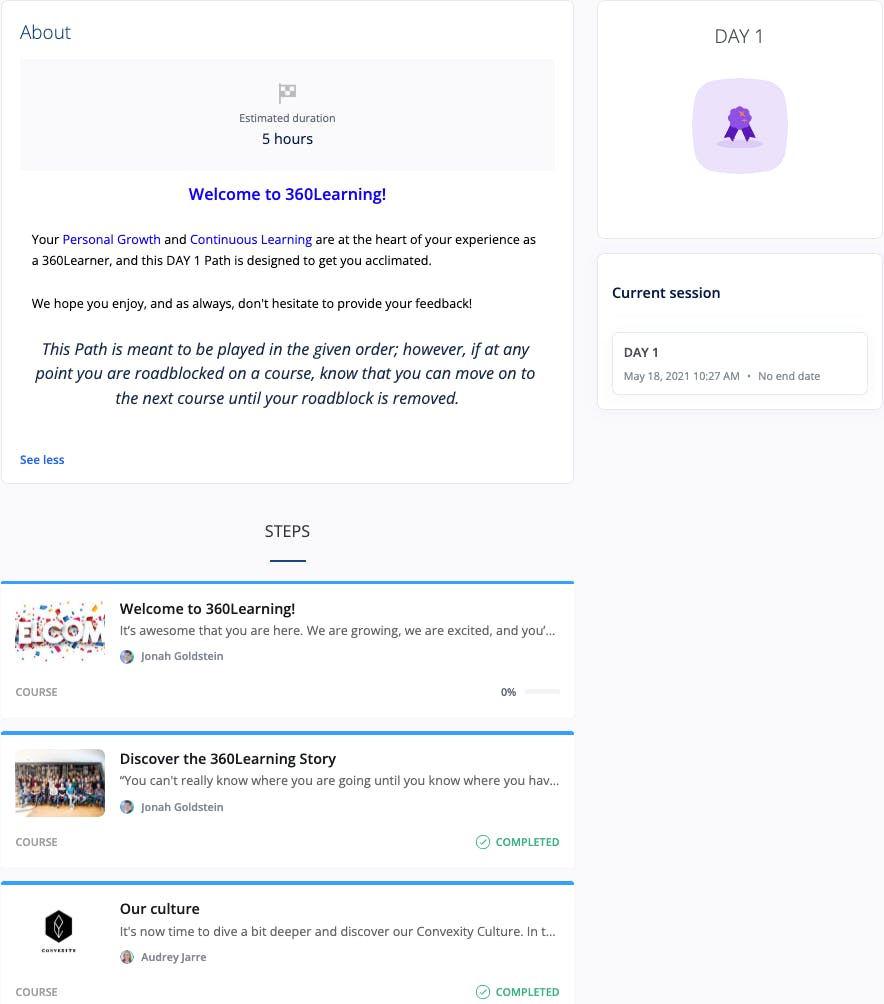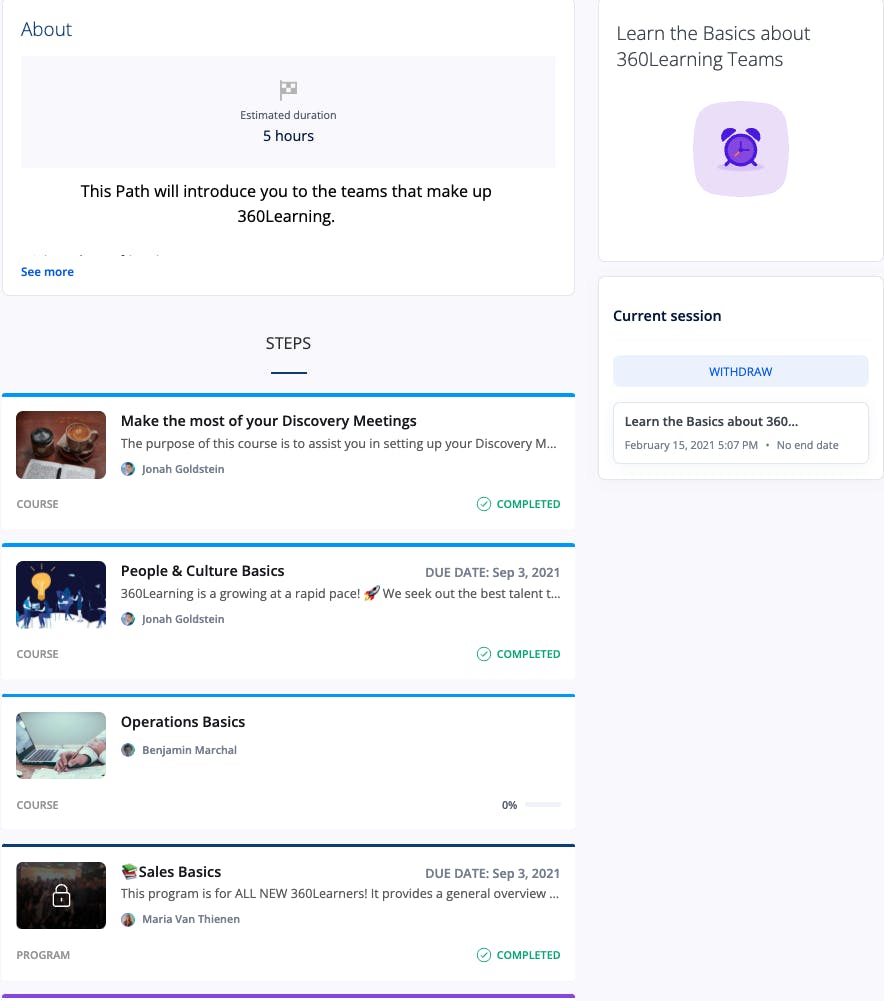For years now, there has been endemic underinvestment in workplace training in the UK.
30% of employees have not received any formal training in the last five years, and six in ten working-age adults don't think they have all the skills they need to thrive during the next five years, according to a new study.
This needs to change. UK organisations need to prioritise development opportunities to address skill gaps and promote continuous learning. As we continue to recover from the COVID-19 pandemic and adjust to rapid technological advancements, workplace training has the potential to play a pivotal role in improving productivity and driving business growth.
That's why implementing the necessary tools and techniques to facilitate and scale learning and development programmes is absolutely critical in today's fast-paced environment. One such technique to make this a reality? Learning paths.
With learning paths, L&D teams have the power to upskill employees, enabling them to master a particular topic or subject quickly. As a result, they're a vital component of a collaborative learning management system, and both L&D teams and learners should leverage them.
In this article, we’ll highlight what learning paths are, as well as explain why you should be using them, and much more.
What is a learning path?
A learning path is a collection of grouped courses that helps learners to master a particular topic or subject. When used with intuitive platforms, L&D managers can adjust them based on the learners' needs.
Learning paths also enable L&D managers to enrol several users in multiple courses in one go, saving time and resources. Therefore, they are a crucial feature that should be leveraged in your collaborative LMS.
Don't have an LMS just yet? Download our RFP template and find the best LMS for your team.
So what’s the rationale behind using learning paths?
Why you should use learning paths in your LMS
An LMS offers substantial benefits for both L&D teams and learners, including saving the organisation a considerable chunk in training costs. Since learning paths are a crucial component of an LMS, utilising them will certainly contribute to those cost savings.
Here are four reasons why you should implement learning paths within your LMS:
- Create structured training. Learning paths enable you to create structured training programmes and give you control over how they are completed. For example, should the courses in your learning path be taken in a specified order, or can the learner choose the order in which they take the courses? Are your courses mandatory or optional? How long does the learner have to complete the learning path? You can adjust these options to match the needs of your learners.
- Make training scalable. L&D teams only need to enrol learners into a particular path once, meaning they're pretty self-sufficient from then on. This saves time by automating repetitive administrative tasks.
- Make training goal-orientated. Learning paths ensure learners are working towards a goal. They also help employees keep on track, stay engaged, and be aware of what's coming without feeling overwhelmed.
- Promote microlearning. This is one of the most popular course structures as it breaks down complex chunks of information into small digestible bites. L&D managers who use this learning method can capture and retain learners' attention while still diving deep into a topic.
These key reasons highlight why you should use learning paths in your LMS. So what types of learning paths are there?
What types of learning paths should you create?
Learning paths take many different shapes and forms. Here, we list two of the most popular learning path use cases.
Learning paths for onboarding employees
By using learning paths during the onboarding process, L&D teams can increase staff retention by 82%, according to a recent study. In addition, organisations that offer personalised learning paths will help employees ramp up quickly and stay engaged throughout their onboarding process.
At 360Learning, we use our Learning Paths feature as part of our onboarding programme. In a new employee's first week, each day constitutes a different learning path. Research has proven that onboarding is the highest-impact period of an employee’s time at your company—with 93% of employers agreeing that onboarding can make or break it when it comes to retention. This is why the day 1 path is mandatory for every new employee to complete on their first day.

We also have a learning path dedicated to all the different teams that make up 360Learning. This is an excellent opportunity to introduce all of the teams and what they do, using a combination of asynchronous and synchronous learning methods. Learning paths showcase each team, and then we follow up with a series of discovery calls so new hires can meet their colleagues in-person or remotely.

Learning paths for partners and customers
Learning paths are not just restricted to employees. They're also a great partner and customer education tool that can help improve overall customer satisfaction. For example, 360Learning helped Mitsubishi Electric UK with their customer training programme enabling them to reduce their training costs by 65% and improve customer satisfaction by 99%.
Once you’ve identified the best learning path use case for your organisation, there are a few best practices you should follow.
Related:Onboarding, Ramp-up, and Beyond: What You Can Expect From the 360Learner Journey
How to strengthen your learning paths
Learning paths are a great organisational tool, but L&D managers have a pivotal role to play in making their courses effective. We have compiled four practical tips that you can use to strengthen your learning paths.
- Ensure your learning paths are aligned with organisational objectives
Before creating learning paths, first, conduct an organisational analysis. Which courses are more aligned with your organisational objectives? If you already have learning paths, are they helping you achieve these objectives? Identify the most critical goals and then create courses that will help your employees achieve them.
- Personalise your learning paths
Learners are different, and a one-size-fits-all approach can’t address the particular needs and preferences of each learner. Instead, you need to identify the different learning styles of your employees and then create courses around their preferences. For instance, you could offer options such as blended learning. You could also use mobile device-based learning, which has increased by 70% over the past three years.
Customising learning paths based on your employees' needs ensures that they all gain from the programme irrespective of their differences.
- Encourage learners to identify their own learning needs
Ask your employees the skills that they'd like to develop. This is an excellent strategy as it shows your staff that you care about them and converts them into learning partners. We recommend that you conduct a bottom-up training needs analysis as it's inclusive and allows all company members to submit their training needs.
- Implement a learning path feedback loop
Create a learning environment where both you and employees can give each other feedback. Employee feedback will help you streamline the courses. Your feedback, on the other hand, will help employees improve their productivity and efficiency.
These best practices will help you strengthen your learning paths. But what learning path features should you look for in your LMS?
Related: Learning Needs Tool: Ship Training Your Team Actually Wants With Collaborative Learning
Must-have learning path features
Learning paths are a crucial component of your learning management system. To reap the benefits of learning paths, we recommend that you look out for these features in your LMS:
- Linear and non-linear learning paths. Liner paths highlight the order in which learners should take a course. Non-linear paths, on the other hand, give learners the flexibility to decide how they'd like to progress through a learning path. This makes it faster and easier to set courses and oversee learner progress.
- Relative due dates for steps. Look for a feature that saves time and effort from manually setting due dates for every learner within a path. Instead, go for a solution that allows you to select deadlines for each path step based on a learner's enrollment date.
- Dashboard analytics. Understand how each path is performing based on the number of learners who have started, completed, and are late on the path. Then, dive deeper into learners' individual stats - status, average score, and final due date. This will help to know exactly where people might need help.
- Collaborative features. Make sure your LMS allows you to incorporate a feedback loop on your learning paths. Utilising features such as discussion forums, relevance scores, and reactions will help L&D teams work collaboratively, monitor engagement, and identify opportunities to make improvements to learning paths over time.
Related: The Secret to Training Engagement Is Surprisingly Simple
Tailor the journey for your teams with learning paths
Learning paths are essential to organisational productivity—you can't afford to ignore them.
Collaborative learning paths offer particular benefits and advantages for L&D teams wanting to shape the learning experience for each individual. This is because they create a training environment where employees can share their expertise and knowledge, teaching and learning from each other. These types of learning paths also encourage a feedback loop during your course, allowing you to make improvements and get a sense of how engaged employees are.
Want to see what a learning path looks like in practice? Check out how we use Learning Paths in the 360Learning platform!




